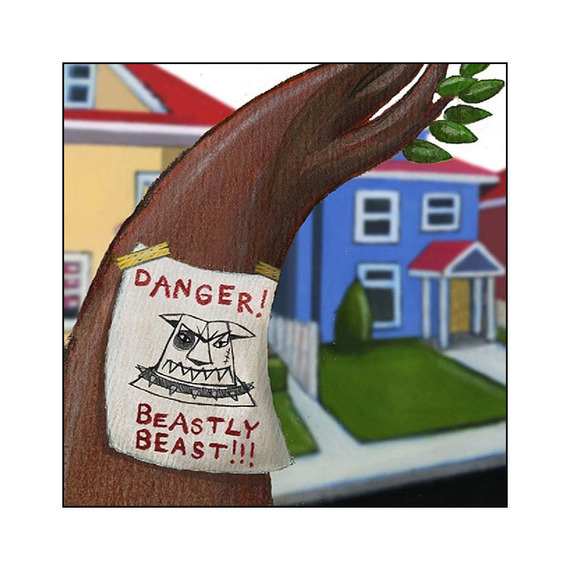When you take up the cause of the so-called pit bull, you make a lot of charming friends. Particularly fetching is the person on Twitter who calls herself "Eradicate Pits." Ms. Eradicate has targeted me, in particular, because I suggested that people like her are -- and I used the word in its precise sense -- ignorant. Nobody likes to be called ignorant. Even if I pointed out that ignorance is easily cured.
Worse: I am collaborating on a children's book aimed at curing this ignorance on a mass scale. We are encouraging families to consider adopting bully types from shelters, since these dogs are being slaughtered at an appalling rate. Dogs, like humans, are individuals. We have the gall to suggest that a friendly, socialized dog of the so-called "pit bull" type is perfectly safe around your children, whereas an aggressive dog that happens to be a Lab, or a Poodle, or a Golden Retriever is definitely not.
(The other part of the "we" is Dula Yavne, an artist from Tel Aviv, whose illustrations are being used here to decorate an otherwise bland article.)
Full disclosure: Ms. Eradicate and I are not really friends. And I don't foresee a toasty friendship in our future. In fact, I'm not entirely sure she's a woman -- let's face it: "Eradicate" is a name equally popular for both girls and boys.
At any rate, this person referred me to YouTube, where I would see something (no doubt gruesome) that would convince me that the pit bull was uniquely dangerous in the canine world.
This is the quality of argument I'm up against: why trust rigorous scientific studies, when I could be consulting YouTube?
I considered her advice, for a small fraction of a nanosecond, and then -- instead of YouTube (that peerless fount of truth) -- I decided to contact a genuine expert.
Brad Griggs, based in Australia, is renowned internationally as an authority in canine behavior. He trains dogs to do extraordinary things. They then proceed to do those things all around the world: he raised and developed a dog, for instance, used by the Saudis to detect arson.
I spoke to Brad because one of his specialties is aggressive behavior. And he comes at this from an interesting angle: Brad started out by training dogs to be aggressive.
That's how you prepare dogs for the military and law enforcement. The point, however, is controlled aggression: you have to take their natural instinct to bite and hold, and refine it so that it's available on command. The flip side of this is you don't want to see that aggression when it's not welcome: you have to be able to turn it off.
If you truly understand what drives a dog to do something, you gain unique insight: you know what compels it not to do that same thing.
These days Brad's putting that knowledge towards the prevention of dog bites.
As in America, the Australian media isn't shy about covering canine incidents. To put it mildly. And Brad's the guy the national media often turns to when they're trying to understand these situations.
I figure I'd rather listen to him than watch a distressing (and predictable) video on YouTube. So I ask him about the science behind eradicating pit bulls. The polite term for how this is accomplished -- eradication -- is BSL: Breed Specific Legislation.
He's refreshingly blunt: "There is no peer-reviewed study available that supports Breed Specific Legislation. All studies categorically refute BSL: they reject it outright; they reject its components; they reject its underlying premise."
Brad doesn't like talking about "pit bulls" -- the whole point of rejecting this discredited stuff is not to concentrate on individual breeds. "A dog is a dog is a dog. There's nothing mystical about a pit bull, other than the press release."
Still, I thought I'd ask him about some of the arguments made against pit bulls, specifically, to see whether he could put these in perspective.
Perhaps the most notorious and ubiquitous argument is this: pit bulls are said to have an abnormally fierce prey drive, and an abnormally high tolerance of pain.
You occasionally find this thesis in respectable places. People on the eradication side of the fence are especially fond of quoting from an article in The Economist, which asserts -- among other things -- that "pit bulls are incredibly tenacious. Once they are fixed on a target, they are all but impossible to distract." The Economist suggests that "this is due to the dogs' insensitivity to pain."
Brad has an interesting take on this. First, it's not especially true of pit bull types, but if it were, it would be a good thing. Intense prey drive, far from making a dog dangerous, is what makes it controllable: "The more driven a dog is to do things like chase -- the better its hunger -- the easier it is to teach." Pain is irrelevant: "We don't have to rely on pain to teach a dog something. In fact, that is rarely helpful."
So, if that formidable prey drive were somehow unique to pit bulls, it would make them less dangerous: it would make them easier to train.
Hence, The Economist isn't just wrong here. It's wrong about its own wrong conclusions. It's wrongness squared.
In defense of The Economist: they published this article in 1991. But the damage is done. People who want to eradicate pit bulls still haul out this decades-old article, triumphantly, again and again -- it's a posh source, and the argument sounds nicely scientific.
Brad reiterates that it really is unhelpful to separate dogs into categories this way: it generally won't tell you anything useful about an individual dog. "'Pit bull' is a term that says nothing about temperament; just about looks."
(It's not even a breed: the dogs usually designated as "pit bulls" fall into a poorly defined category, involving a number of breeds, and all sorts of mutts.)
Still, if you're dying to make this argument -- that a type stands out, based upon these specific characteristics -- then you might want to concentrate on a somewhat different dog.
America's most maligned dog may be the so-called pit bull, but the nation's most beloved dog is beyond question: the Labrador Retriever. For years it has topped the list of dogs registered with the American Kennel Club.
Now, what precisely is a Labrador retriever? Not many people bother to think about this.
Labrador is the northernmost part of the Canadian province of Newfoundland and Labrador. It's on the mainland, separated from the island of Newfoundland by the narrow Strait of Belle Isle.
It's really cold.
I mean cold. Most of Labrador sits at the same latitude as Siberia. It's not uncommon to see winter temperatures of 40 below (which is where Celsius and Fahrenheit meet, to share a bottle of cheap vodka).
Right. The Labrador Retriever was bred to dive into the sea here: waters technically designated as "sub-arctic." If you don't think that requires an extraordinary tolerance for pain, I suggest you don your Speedo and give it a go.
Oh, and why do they subject their canine bodies to this kind of excruciating experience? Simple: prey drive. A Labrador retriever has to retrieve. And the way you get a dog to do that is to instill it with an iron will to pursue its prey. Here the prey is a bit peculiar: the floats attached to fishermen's nets.
So, America's favorite dog was bred, over the course of generations, to exhibit these qualities, amongst others: an uncanny tolerance of pain, and an ability to remain committed to an activity under extreme duress.
Note how nobody is calling for the eradication of the Labrador Retriever.
That would be not simply evil, but foolish. First, we've just demonstrated that these qualities do not make a dog dangerous: they make a dog trainable. Second, these desirable qualities very quickly diminish when a dog isn't specifically bred to work. This is why you find all sorts of pet Labs that would be comically useless in Labrador. They don't even want to play fetch.
(Full disclosure: I love Labrador Retrievers. I find them no more frightening than "pit bulls." Please don't eradicate them. Thanks in advance.)
Ms. Eradicate Pits seems to be focused on another detail, which you hear often in discussions of the so-called pit bull: their jaws are said to be different, in some special and scary way.
Here I'll refer you to an academic: Dr. I. Lehr Brisbin of the University of Georgia. "The studies which have been conducted of the structure of the skulls, mandibles and teeth of pit bulls show that, in proportion to their size, their jaw structure, and thus its inferred functional morphology, is no different than that of any other breed of dog of comparable size and build."
Okay, but surely we can prove that those jaws are unnaturally powerful, no? Well, no. The science here is a bit soft -- the only study of canine jaw strength is not very rigorous -- but it does yield a credible conclusion: Dr. Brady Barr of National Graphic determined that the pit bull's jaw exerts a force, in pounds per square inch, just slightly less than the force of America's second favorite dog: the German Shepherd. (And, sorry: German Shepherds are pretty average in this regard. Please don't eradicate them.)
Finally, I ask Brad -- since he has spent years training dogs to excel for the police and the military -- why he never seems to choose some variety of pit bull. He has told me that he prefers Belgian Malinois, Dutch Shepherds, German Shepherds, sometimes Rottweilers. His response? "Typically speaking, pit types don't have the characteristics that lend themselves to biting people."
Uh, that's kind of scandalous. These demon dogs aren't good at biting humans? Brad apologizes on their behalf: "Most dogs are no good at it. "
This has nothing to do with physical attributes: "It's not a question of how the jaws work -- that's purely mechanical. If sheer mechanical aptitude were the issue, then we'd really need to look at banning all dogs over about 15 kg. Even small dogs like Pomeranians and Jack Russells have killed infants.
"It's not about the engineering that a breed brings to a confrontation; it's about the willingness of the dog to apply that engineering. You have to remember that pits were bred selectively to be non-aggressive to humans, even under severe duress and pain."
I'm sure that Ms. Eradicate will discern some conspiracy here: surely Brad Griggs has some terrible reason for saying such terrible things about pit bulls? Not good at biting people?
The issue, regrettably, is this. Brad makes his living training dogs for specific tasks. If pit bull types were the best at this task, he'd be lousy at his job if he did not choose them over other breeds. You're really going to offer your client a lesser alternative?
Unfortunately for Ms. Eradicate, Brad Griggs is not lousy at his job. Nobody calls me when they need a dog trained to sniff out arson, or to track and apprehend bad guys. My guess is that Ms. Eradicate is rarely first in line for this gig either. (For what it's worth, Brad doesn't find so-called pit bulls completely unimpressive. "They may make a great detection dog. They're just not typically good for offender work.")
Now there are those out there -- lots of them -- who will defer to Ms. Eradicate and YouTube. Who speak sneeringly about "experts." Who murmur darkly about "the pit bull lobby" -- a cabal of conspirators who bury the truth, presumably because there's big money in lying about pit bulls. You're welcome to listen to these people. Like most conspiracy theorists, they're depressingly easy to find.
What drives people to this stance is not always comical. The most virulent enemies of the so-called pit bull are often the victims of serious dog bites. Sadly, these are the people least likely to bring reason to the debate.
If your first experience of the sea is near-drowning, then you will be terrified of the open water. Drowning anecdotes aren't rare; they will reinforce your terror. It may take the kind of objectivity you simply cannot muster when your child wants to take a ride in a boat. Even a boat that experts deem overwhelmingly safe if handled correctly.
And you are not the sort of person who should be determining marine legislation.
In the same way there are those who, as a result of personal trauma, will never be able to see the truth about these perfectly ordinary dogs. They will not listen to experts, because they cannot listen to experts.
It's in their interest, ironically, if we do not listen to them: we owe it to victims to prevent future dog bites the best way we know how. Of course we have to respect their suffering, but it would be a terrible mistake to let them hijack policy, and to legislate the slaughter of these good animals.
(All illustrations by Dula Yavne. If you have been following the Galunker project, and wish to pledge, please note that the Kickstarter Campaign ends in three days.)





